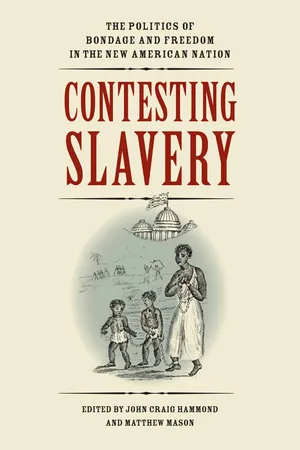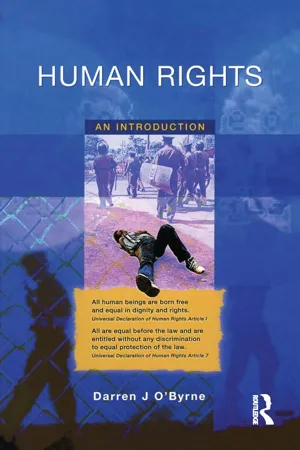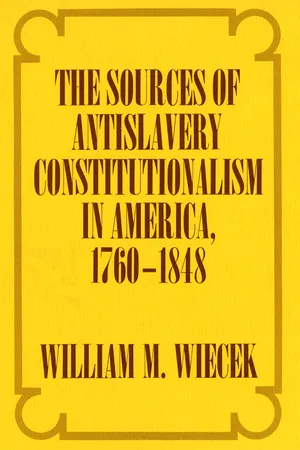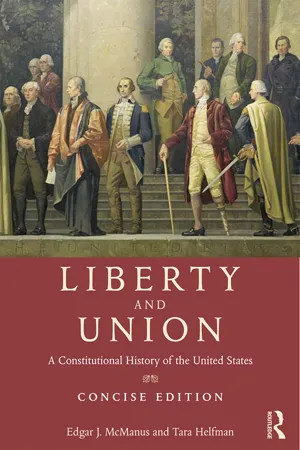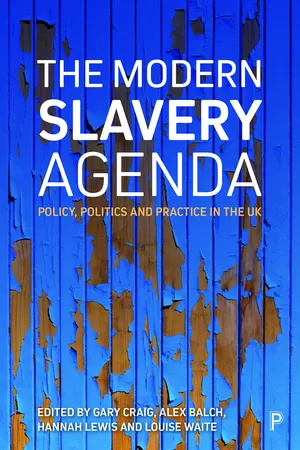Politics & International Relations
Slavery and the Constitutional Convention
During the Constitutional Convention, the issue of slavery was a contentious topic. Southern states wanted to count slaves as part of their population for representation in Congress, while Northern states opposed this. The Three-Fifths Compromise was eventually reached, counting each slave as three-fifths of a person for both representation and taxation purposes.
Written by Perlego with AI-assistance
Related key terms
7 Key excerpts on "Slavery and the Constitutional Convention"
- Matthew Mason(Author)
- 2009(Publication Date)
- The University of North Carolina Press(Publisher)
132 As antislavery activists saw slavery entering politics, they hoped its connection to national interest and reputation would lend a greater urgency to their cause among the otherwise uncommitted.Slavery also showed signs of usefulness on the domestic political front in America after the Revolution. The political serviceability of slavery in all its variety was on full display in the debates surrounding the drafting and ratification of the United States Constitution between 1787 and 1789. Many historians have posited the centrality of slavery to the Constitutional Convention and the ratification debates that followed. But for most players, slavery constituted a secondary issue that could be used to great advantage in pressing their respective points of view regarding the primary topics at hand.133This was true at the Philadelphia Convention, where discord between the small and large states concerning representation in the new Congress formed the most important divide. The question of whether to count slaves toward each state’s congressional presence was contentious, but most often it came into play in the context of the larger debate over representation. James Madison famously asserted in his notes of the Convention’s debates that the vital division was not between large and small states, but rather between slave and free states. But a month before he made this characterization, Madison had urged his fellow delegates to set aside the issue of counting slaves for representation, so as not to distract from the real business at hand, proportional representation by population. Indeed, his colleagues agreed that “every thing depended on” whether states would be counted equally or by population. Only after a full month of bruising debate did Madison circle back and suggest that the free state—slave state divergence was the crucial one.134 This suggests that his famous formulation should be taken more as a diversionary tactic than at face value. Furthermore, New Jersey led the fight against slave representation in Philadelphia, a curious stand for a state with one of the largest slave populations in the North.135 Apparently, the delegates from this small state thought that by attacking slave representation, they could effectively undermine the principle of popular representation with which it was bound. On the other hand, delegates from the large state of Massachusetts, later the home of slave representation’s leading foes, were ambivalent on the issue in Philadelphia. As Northern politicians had done in previous debates over counting slaves, they supported it if it increased the South’s tax burden but not if it increased the South’s representation. Some Massachusetts delegates did object to counting slaves, but as a whole the Massachusetts delegation compromised on the issue.136- eBook - ePub
Jeffersonian America
The Politics of Bondage and Freedom in the New American Nation
- John Craig Hammond, Matthew Mason, John Craig Hammond, Matthew Mason(Authors)
- 2011(Publication Date)
- University of Virginia Press(Publisher)
The Collected Works of Abraham Lincoln, ed. Roy P. Basler (New Brunswick, N.J.: Rutgers University Press, 1953), 3:275–83 (quotation at 276).2 . The historiography on slavery and formative-era law and politics includes sources cited in the introduction to this volume, particularly notes 2 and 3; and Mark A. Graber, Dred Scott and the Problem of Constitutional Evil (Cambridge: Cambridge University Press, 2006); Robin L. Einhorn, American Taxation, American Slavery (Chicago: University of Chicago Press, 2006); Staughton Lynd, Class Conflict, Slavery, and the United States Constitution: Ten Essays (Indianapolis: Bobbs-Merrill, 1967); and William M. Wiecek, The Sources of Antislavery Constitutionalism in America (Ithaca, N.Y.: Cornell University Press, 1977). Slavery’s powerful role in shaping early American law and politics is analyzed in George William Van Cleve, A Slaveholders’ Union: Slavery, Politics, and the Constitution in the Early Republic (Chicago: University of Chicago Press, 2010).3 . For differing views on the significance of the Constitution in slavery’s history, compare the works of Don Fehrenbacher (The Dred Scott Case: Its Significance in American Law and Politics [New York: Oxford University Press, 1978], and The Slaveholding Republic: An Account of the United States Government’s Relations to Slavery [New York: Oxford University Press, 2001]), with those of Paul Finkelman (Slavery and the Founders: Race and Liberty in the Age of Jefferson, 2nd ed. [Armonk, N.Y.: M. E. Sharpe, 2001]), and Staughton Lynd (Class Conflict, Slavery, and the United States Constitution). For further discussion of the historiography, see David Waldstreicher, Slavery’s Constitution: From Revolution to Ratification (New York: Hill and Wang, 2009), 10–19.4 . For British colonial slavery policy, see Robin Blackburn, The Making of New World Slavery (London: Verso, 1997), especially 383–92; and David Richardson, “The British Empire and the Atlantic Slave Trade, 1660–1807,” in The Oxford History of the British Empire, - eBook - ePub
Human Rights
An Introduction
- Darren O'Byrne(Author)
- 2014(Publication Date)
- Routledge(Publisher)
The Supplementary Convention on the Abolition of Slavery, the Slave Trade, and Institutions and Practices Similar to Slavery was adopted by the United Nations on 7 September 1956 and came into effect on 30 April 1957. Drawing heavily on the 1926 Convention, and on the 1948 Universal Declaration of Human Rights, the Supplementary Convention made it clear that the practice or endorsement of, and any participation in, slavery, the slave trade, or similar institutions (including debt bondage and serfdom), was a criminal offence liable to severe punishment. In a related development, the International Covenant on Economic, Social and Cultural Rights of 1966 emphasised the right to work and to receive a fair wage from that work. The International Covenant on Civil and Political Rights of the same year added a provision prohibiting most forms of unfree labour. In an important case heard in 1970, the International Court of Justice made it clear that slavery is understood by the international community to be a criminal offence, regardless of whether a particular government has ratified the various treaties, by listing the protection from slavery as one of two obligations erga omnes (that is, obligations owed by a state to the international community itself). 36 Finally, at the Rome Final Act of 1998, slavery was defined as a crime against humanity and placed under the jurisdiction of the International Criminal Court. These major acts may be summarised, following Bales and Robbins, as shown in Table 8.1. Slavery in the contemporary world It would, sadly, be a mistake to believe that, thanks to the various inter-national covenants and conventions discussed above, slavery has been fully abolished. Like so many other human rights violations, it is as common today as it has been at any point in the past, perhaps more common. Nor should we in the West seek comfort in a belief that, even if slavery does still exist, at least we have abolished it - William M. Wiecek(Author)
- 2018(Publication Date)
- Cornell University Press(Publisher)
3Slavery in the Making of the Constitution
The Confederation Congresses had demonstrated that decisions concerning slavery could be incorporated into national policy making without disturbing the federal consensus. But the inadequacies of national authority under the Articles led nationalists to work for a change in the constitutional basis of the American federation, and this provided an opportunity for some slave-state representatives to establish slavery more securely under national authority. As a result of their efforts, the Philadelphia Convention inserted no less than ten clauses in the Constitution that directly or indirectly accommodated the peculiar institution. They were:1. Article I, section 2: representatives in the House were apportioned among the states on the basis of population, computed by counting all free persons and three-fifths of the slaves (the “federal number” or “three-fifths” clause);2. Article I, section 2 and Article I, section 9: two clauses requiring, redundantly, that direct taxes (including capitations) be apportioned among the states on the foregoing basis, the purpose being to prevent Congress from laying a head tax on slaves to encourage their emancipation;3. Article I, section 9: Congress was prohibited from abolishing the international slave trade to the United States before 1808; 4. Article IV, section 2: the states were prohibited from emancipating fugitive slaves, who were to be returned on demand of the master; 5. Article I, section 8: Congress was empowered to provide for calling up the states’ militias to suppress insurrections, including slave uprisings; 6. Article IV, section 4: the federal government was obliged to protect the states against domestic violence, again including slave insurrections; 7. Article V: the provisions of Article I, section 9, clauses 1 and 4 (pertaining to the slave trade and direct taxes) were made unamendable;8. Article I, section 9 and Article I, section 10: these two clauses prohibited the federal government and the states from taxing exports, one purpose being to prevent them from taxing slavery indirectly by taxing the exported products of slave labor.- eBook - ePub
Slavery and the Founders
Race and Liberty in the Age of Jefferson
- Paul Finkelman(Author)
- 2014(Publication Date)
- Routledge(Publisher)
A careful reading of the Constitution reveals that the Garrisonians were correct: the national compact did favor slavery. A detailed examination of the Convention of 1787 explains how the Constitution evolved in this way. Both the text of the Constitution and the debates surrounding it help us understand that the “more perfect Union” created by this document was in fact fundamentally imperfect.Slavery in the Constitutional Structure
The word “slavery” appears in only one place in the Constitution—in the Thirteenth Amendment, where the institution is abolished. Throughout the main body of the Constitution, slaves are referred to as “other persons,” “such persons,” or in the singular as a “person held to Service or Labour.” Why is this the case?Throughout the debates, the delegates talked about “blacks,” “Negroes,” and “slaves.” But the final document avoided these terms. The change in language was clearly designed to make the Constitution more palatable to the North. In a debate over representation, William Paterson of New Jersey pointed out that under the Articles of Confederation Congress “had been ashamed to use the term ‘Slaves’ & had substituted a description.” This shame over the word “slave” came up at the Convention during the debate over the African slave trade. The delegates from the Carolinas and Georgia vigorously demanded that the African trade remain open under the new Constitution. Gouverneur Morris of Pennsylvania, furious at this immoral compromise, suggested that the proposed clause read: the “Importation of slaves into N. Carolina, S— Carolina & Georgia” shall not be prohibited. Connecticut’s Roger Sherman, who voted with the Deep South to allow the trade, objected, not only to the singling out of specific states, but also to the term “slave.” He declared he “liked a description better than the terms proposed, which had been declined by the old Congs & were not pleasing to some people.” George Clymer of Pennsylvania “concurred” with Sherman. In the North Carolina ratifying convention, James Iredell, who had been a delegate in Philadelphia, explained that “the word slave is not mentioned” because “the northern delegates, owing to their particular scruples on the subject of slavery, did not choose the word slave to be mentioned.” Thus, southerners avoided the term because they did not want unnecessarily to antagonize their colleagues from the North. As long as they were assured of protection for their institution, the southerners at the Convention were willing to do without the word “slave.”8 - eBook - ePub
Liberty and Union
A Constitutional History of the United States, concise edition
- Edgar McManus, Tara Helfman(Authors)
- 2014(Publication Date)
- Routledge(Publisher)
IXSlavery and the Constitution“The right of property in a slave is distinctly and expressly affirmed in the Constitution … in plain words—too plain to be misunderstood.”—Chief Justice Roger B. Taney, Dred Scott v. Sandford (1857)Of all the issues that divided Americans during the antebellum period, the most bitter and persistent was the controversy over slavery. Organized opposition to the institution began during the Revolutionary War. Sentiment against slavery during the colonial period had been fragmented and typically took the form of religious and moral opposition. The natural rights idealism of the Revolutionary era brought it into sharper focus, making it difficult for white Americans to claim freedom for themselves while denying it to African Americans. Most did not try, not even in the South, where slavery had its deepest roots. Washington, Jefferson, and Madison, southerners and slaveholders as well, supported the idea of gradual emancipation. Jefferson’s first draft of the Declaration of Independence deplored the slave trade and condemned Great Britain for disallowing colonial laws against the “execrable commerce.” Luther Martin considered the existence of slavery “inconsistent with the principles of the Revolution, and dishonorable to the American character.” John Jay, a leader of the antislavery movement in New York, thought that unless Americans took steps to end it their own “prayers to heaven for liberty will be impious.”Antislavery Movement
Sentiment against slavery spread so rapidly in the North that by 1806 every northern state had made some provision for abolishing it. The demise of the institution did not mean racial justice or legal equality for blacks. The politics of emancipation often had less to do with idealism than with the political and economic interests of whites. The predominantly industrial economy of the North was not as dependent on slave labor as the agricultural South. What is more, North and South alike were acutely aware that the most dangerous aspect of slavery was the slaves themselves. As one colonial abolitionist wrote, “Instead of being a defence and support of the common-wealth, [slaves] are often its terror, and sometimes its destruction. For it must be constantly expected, that a slave will improve every opportunity to throw off his burthen, and imposition.”1 - eBook - ePub
The Modern Slavery Agenda
Policy, Politics and Practice
- Craig, Gary, Balch, Alex(Authors)
- 2019(Publication Date)
- Policy Press(Publisher)
However, what the black letter of the law says is one thing. How that law is interpreted, or whether it is enforced, can be something else entirely. So, when considering the question of how there can still be so much slavery in the world when there are so many laws banning it, it is perhaps useful to consider the idea of political economy. For the purposes of this chapter, the term ‘political economy’ is taken to mean the laws, policies and customs that we, as human societies, use to govern business, trade, employment, income and wealth. In many parts of the world, the principles of human rights are not foundational to the conduct of these issues. So, when viewed from this perspective, it can be argued that slavery has become not so much banned, but rebranded, that is, slavery persists across the world but is simply called by other names, facilitated by different laws (by omission or commission) or simply ignored by those with the power to end the diverse practices of contemporary slavery.The chapter will begin by setting out the root causes of slavery, and demonstrating the fundamental role of the failure of the rule of law in enabling slavery to persist. It will then set out how particular failures in the rule of law give rise to four ‘peacetime’ political economies of slavery. Where international mechanisms exist to uphold human rights standards, these political economies may be reformed somewhat. However, in addition, what is needed is a more fundamental reform of the nature of all political economies to establish processes to empower vulnerable individuals and groups and to uphold human rights standards. This chapter then sets out what forms these reforms must take to establish political economies with the potential to reduce slavery, if not eliminate it completely.The constituent elements of slavery
Contemporary slavery reflects a diversity of human experience: a life lived in bonded labour in Indian brick kilns is different in important respects from that of a Nepalese domestic worker in Lebanon, someone born into chattel slavery in West Africa, a ‘restavek’ child slave in Haiti or a forced labourer in American agriculture. However, in spite of the spectrum of experiences catalogued in contemporary and historical slavery, empirical studies conducted by Anti-Slavery International (see, eg, Upadhyaya 2008; Anti-Slavery International et al 2006) indicate that slavery emerges at the conjunction of three common factors: individual vulnerability (usually, but not exclusively, emerging from poverty); social exclusion; and failure of the rule of law. When demands for cheap labour and reduced costs are introduced into these situations by unscrupulous employers, they act as a catalyst to create slavery and exploitation. This analysis is similar to that offered by LeBaron et al (2018) (see Figure 1.1
Index pages curate the most relevant extracts from our library of academic textbooks. They’ve been created using an in-house natural language model (NLM), each adding context and meaning to key research topics.

